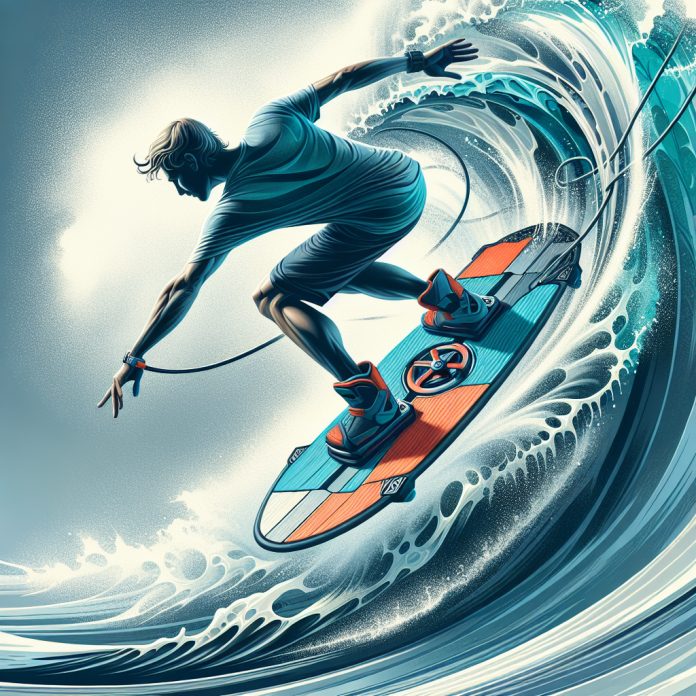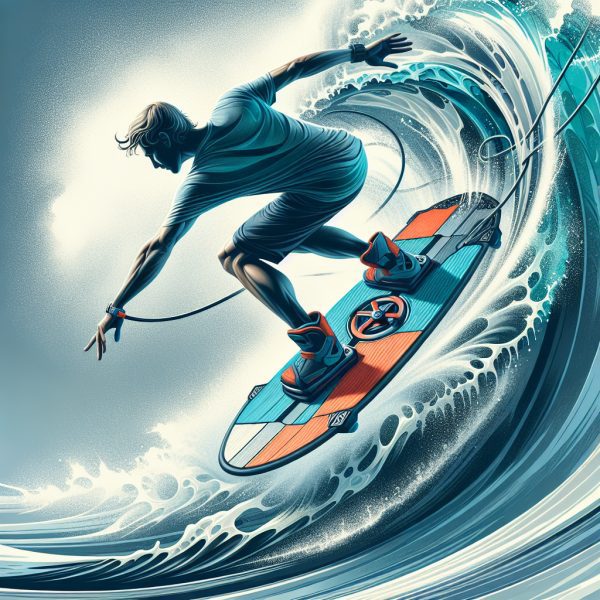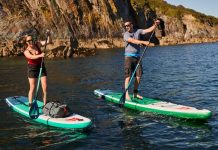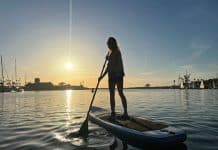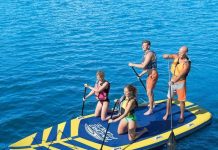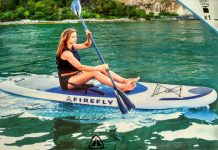Ready to embark on an exhilarating adventure that combines the thrill of riding waves with the skill of snowboarding? Look no further than flowboarding, an adrenaline-pumping sport that allows you to conquer the waves on a flowboard. This exciting activity puts you at the helm, riding the wave’s crests with finesse and style. Whether you’re a seasoned pro or a first-time rider, flowboarding is an experience that guarantees high-flying fun on an innovative and versatile watercraft. Get ready to embrace the rush of the ocean as we take a deep dive into the world of flowboarding.
What is Flowboarding?
Flowboarding is an exciting and dynamic water sport that combines elements of surfing, skateboarding, and bodyboarding. It involves riding artificial waves created by a machine known as a FlowRider, which simulates the feel and challenges of riding ocean waves. Flowboarding provides a thrilling experience for riders of all ages and skill levels, allowing them to carve, perform tricks, and ride the waves in a safe and controlled environment.
Definition of Flowboarding
Flowboarding can be defined as a water sport that involves riding a specially designed board called a flowboard on a FlowRider. The aim is to navigate the artificial waves created by the machine by using a combination of balance, skill, and technique. It offers a unique and exhilarating experience that combines the adrenaline rush of surfing with the creativity and style of skateboarding.
Origins and Evolution of Flowboarding
Flowboarding originated in the late 1980s in Southern California, when engineers Tom Lochtefeld and his team developed the first FlowRider machine. The idea behind this invention was to create an artificial wave system that could be used for both recreational purposes and as a training tool for professional surfers. Over the years, Flowboarding has evolved and gained popularity worldwide, with dedicated flowboarding parks and competitions being established in different countries.
Flowboarding versus other Water Sports
Flowboarding stands out from other water sports due to its unique combination of elements from surfing, skateboarding, and bodyboarding. Unlike traditional surfing, which requires the natural presence of ocean waves, flowboarding provides consistent waves that can be customized for different skill levels. Furthermore, flowboarding offers riders the ability to perform tricks and maneuvers similar to those found in skateboarding, while also incorporating the bodyboarding element of riding prone or on the belly. This versatile sport appeals to a wide range of water sports enthusiasts, providing an accessible and exciting alternative to traditional water-based activities.
Equipment and Gear Needed for Flowboarding
To fully enjoy the flowboarding experience, there are several essential pieces of equipment and gear that riders should have. These items ensure safety, enhance performance, and provide a comfortable ride:
Flowboard
The flowboard is the primary equipment used in flowboarding. It is a specially designed board that resembles a skateboard or bodyboard, featuring a deck, trucks, and wheels. Flowboards are typically made of durable materials such as fiberglass, foam, and carbon fiber, ensuring they can withstand the rigors of riding artificial waves.
FlowRider
The FlowRider machine is the heart of the flowboarding experience. It creates the artificial waves using high-powered pumps that propel water up a sloped surface, simulating the feeling of riding real ocean waves. The FlowRider can be found in dedicated flowboarding parks, indoor facilities, or resorts.
FlowSculpture
FlowSculptures are additional features found within the flowboarding parks that enhance the riding experience. These sculpted structures vary in shape and size and can include ramps, rails, and other obstacles that riders can use for tricks and maneuvers.
Wetsuit or Swimwear
When it comes to choosing the right attire for flowboarding, riders have two main options: wetsuits or swimwear. Wetsuits are recommended for colder water temperatures or indoor facilities with air conditioning. They provide insulation and protection against chafing. For warmer environments, swimwear such as board shorts or bathing suits are suitable.
Safety Gear (Helmet, Knee Pads, Elbow Pads)
Safety should always be a priority when participating in any sport, and flowboarding is no exception. Wearing appropriate safety gear is crucial to prevent injuries. This includes a helmet to protect the head, knee pads to cushion landings and slides, and elbow pads to protect against impact. The use of these protective items significantly reduces the risk of injuries during flowboarding sessions.
Other Optional Gear (Wax, Traction Pads, etc.)
While not necessary, some riders may choose to enhance their performance and grip on the flowboard by using additional gear. Wax is used to increase the grip between the rider’s feet and the board, allowing for better control and maneuverability. Traction pads are also popular among riders, providing additional grip and cushioning for their feet.
Different Flowboarding Techniques
Flowboarding offers a variety of techniques that riders can master to enhance their skills and create a unique riding style. Understanding these techniques is essential for navigating the artificial waves with precision and flair.
Standard Flowboarding
The standard flowboarding technique involves riding the flowboard upright, imitating the stance and movements of a surfer or skateboarder. To maintain balance, riders distribute their weight evenly on the board while using their arms for stability. The goal is to carve and ride the wave, making smooth turns and executing stylish maneuvers.
Tricks and Advanced Maneuvers
Once riders have mastered the basics of flowboarding, they can progress to performing tricks and advanced maneuvers. These include spins, flips, grabs, and aerial maneuvers. Riders can tailor their tricks to their individual style, creativity, and skill level. Flowboarding parks often have areas with dedicated obstacles, such as ramps and rails, to encourage riders to push their limits and showcase their trick repertoire.
Bodyboarding on the FlowRider
Flowboarding also offers the option of bodyboarding, which involves riding the flowboard on the belly or prone position. This technique allows riders to slide down the face of the wave, execute fast turns, and experience the thrill of riding the rushing water close to the surface.
Flowboarding Competitions and Trick Categories
For those looking to take their flowboarding skills to the next level, competitions and trick categories provide an avenue for showcasing talent and competing against other riders. Flowboarding competitions often consist of various divisions, including amateur, professional, and masters categories. Trick categories range from technical maneuvers to aerial tricks, providing a platform for riders of all skill levels to participate and excel.
Health Benefits of Flowboarding
Flowboarding not only offers an exhilarating and fun experience but also provides a range of health benefits. Engaging in this dynamic water sport can have positive effects on both physical fitness and mental well-being.
Full-Body Workout
Flowboarding engages multiple muscle groups, resulting in a full-body workout. Balancing and maneuvering on the flowboard require the activation of core muscles, leg muscles, and upper body muscles. Continuous movement and the resistance provided by the rushing water provide an excellent cardiovascular workout, helping to improve endurance and burn calories.
Improves Balance and Coordination
Maintaining balance is crucial in flowboarding, as riders navigate the artificial waves and execute precise maneuvers. This constant focus on balance helps to improve coordination and proprioception, the body’s ability to sense and control movement. With practice, riders can develop enhanced balance and coordination skills that can translate to other sports and activities.
Cardiovascular Fitness
The fast-paced nature of flowboarding and the constant movement involved provide an effective cardiovascular workout. Riding the waves on a FlowRider stimulates the heart and lungs, increasing oxygen intake and improving overall cardiovascular fitness. Regular flowboarding sessions can contribute to increased stamina, improved endurance, and a healthier cardiovascular system.
Helps Build Core Strength
Flowboarding requires a strong and stable core to maintain balance and control. The continuous engagement of core muscles during rides and maneuvers helps to strengthen and tone the abdominals, obliques, and lower back. Developing a strong core is not only beneficial for flowboarding but also for overall posture, stability, and injury prevention in daily activities.
Stress Relief and Mental Well-being
Engaging in flowboarding can provide an escape from the stresses of daily life and promote mental well-being. The adrenaline rush and focus required during flowboarding sessions help to release endorphins, often referred to as the “feel-good” hormones. This can lead to a reduction in stress levels, improved mood, and increased mental clarity. Flowboarding also offers a sense of accomplishment and self-confidence as riders progress and achieve new tricks and maneuvers.
Safety Tips for Flowboarding
Safety should always be a top priority when participating in any sport, and flowboarding is no exception. Adhering to safety guidelines and taking precautionary measures can help prevent injuries and ensure a safe and enjoyable flowboarding experience.
Receive Professional Instruction
Before attempting flowboarding, it is highly recommended to receive professional instruction. Qualified instructors can teach the proper techniques, safety protocols, and provide valuable guidance during the learning process. They can also assess your skill level and provide personalized tips for progression.
Start with Beginner Sessions
For beginners, it is advisable to start with designated beginner sessions or classes. These sessions offer a controlled environment with slower waves and provide an opportunity to learn the basics without feeling overwhelmed. As skills improve, riders can progress to more challenging waves and maneuvers.
Wear Appropriate Safety Gear
To minimize the risk of injuries, it is essential to wear appropriate safety gear while flowboarding. This includes a well-fitting helmet to protect the head from impact and potential falls. Knee pads and elbow pads provide cushioning and protect the joints during landings and slides. Wearing gear specifically designed for water sports ensures optimal safety and protection.
Know Your Limits
Understanding and respecting your limits is crucial for personal safety when flowboarding. It is important to assess your skill level and only attempt maneuvers and tricks that are within your capabilities. Pushing yourself too hard or attempting tricks beyond your skill level increases the risk of injury. Progress gradually, continuously challenging yourself while staying within your ability range.
Respect Flowboard Etiquette
Flowboarding is a social sport, often shared with other riders in flowboarding parks or facilities. Respecting flowboard etiquette ensures a safe and enjoyable experience for everyone. Yielding the right of way to other riders, being aware of your surroundings, and taking turns on the waves are essential aspects of flowboard etiquette.
Stay Hydrated and Take Breaks
Flowboarding can be physically demanding, so it is crucial to stay hydrated throughout the session. Drinking an adequate amount of water helps to prevent dehydration and maintain optimal performance. It is also essential to take regular breaks to rest and recover, especially on hot days or during extended flowboarding sessions.
Be Aware of Potential Risks
While flowboarding is a relatively safe sport when proper precautions are taken, it is important to be aware of potential risks. These can include falls, collisions with other riders, and impacts with the flowboard or FlowRider structure. Developing good awareness of your surroundings, understanding the flowboarding environment, and following safety guidelines will help minimize these risks.
Best Locations for Flowboarding
Flowboarding can be enjoyed in various locations around the world, ranging from dedicated indoor facilities to outdoor parks and resorts. Here are some of the best locations to experience the thrill of flowboarding:
Indoor FlowRider Centers
Indoor flowboarding centers provide the opportunity to ride artificial waves year-round, regardless of weather conditions. These facilities are equipped with state-of-the-art FlowRider machines and cater to riders of all skill levels. Many indoor centers offer lessons, training programs, and organized events, making them ideal for learning and honing flowboarding skills.
Outdoor FlowRider Parks
Outdoor flowrider parks are often found in warm climates and provide a unique outdoor setting to enjoy flowboarding. These parks offer larger wave systems and expanded areas for riders to showcase their skills. With ample space and a vibrant atmosphere, outdoor flowrider parks are popular among both local and visiting riders.
Flowboarding Resorts and Beaches
Many beach resorts and coastal destinations around the world have embraced flowboarding as a popular water sport activity. These resorts often feature dedicated flowboarding areas within their premises, allowing guests to enjoy the sport while also indulging in the beauty and serenity of the surrounding beach environment. Flowboarding resorts offer a refreshing combination of relaxation and adventure.
Flowboarding Destinations Worldwide
Flowboarding has gained international recognition, with dedicated flowboarding parks and destinations in various countries. From the United States and Canada to Europe, Asia, and Australia, flowboarding enthusiasts can find incredible locations to ride the waves and experience the thrill wherever they travel. These destinations offer diverse and unique flowboarding experiences, making them must-visit spots for flowboarding enthusiasts.
Flowboarding Events and Competitions
For those passionate about flowboarding, participating in events and competitions is an excellent way to showcase skills, meet fellow enthusiasts, and immerse oneself in the pulsating flowboarding community. Here are some prominent flowboarding events and competitions:
World Flowboarding Championships
The World Flowboarding Championships are the pinnacle of competitive flowboarding. This annual event brings together the world’s best flowboarders to compete in various divisions, including professionals, amateurs, and masters. The competition showcases breathtaking skills, impressive tricks, and high-flying maneuvers, making it a spectacle for both riders and spectators alike.
Flowboarding Pro/Am Tours
Flowboarding Pro/Am Tours are regional or national tours that take place in different locations. These tours are designed to provide opportunities for both professional and amateur flowboarders to compete at various levels and gain exposure. These events contribute to the growth and development of the sport, while also providing a platform for riders to gain recognition and sponsorship opportunities.
Regional and Local Flowboarding Contests
At a regional and local level, flowboarding contests provide an opportunity for riders of all skill levels to compete and test their abilities. These contests often take place within flowboarding parks and facilities and may have categories for different age groups and skill levels. Participating in regional and local contests allows riders to gain experience, receive feedback, and foster camaraderie within the local flowboarding community.
Flowboarding Special Events and Exhibitions
Beyond the official competitions, flowboarding special events and exhibitions offer additional opportunities for riders to showcase their skills and interact with the flowboarding community. These events may include demo sessions, flowboard showcases, and exhibitions by professional riders. Special events provide a platform for riders to learn from experts, try new equipment, and engage with likeminded individuals who share their passion for flowboarding.
Flowboarding for All Ages and Skill Levels
Flowboarding caters to a wide range of ages and skill levels, making it an inclusive water sport that can be enjoyed by everyone. Here are some specific groups that can benefit from and enjoy flowboarding:
Kids and Family Flowboarding
Flowboarding is a fantastic activity for children, providing them with a thrilling and unique water sport experience. Many flowboarding parks offer family-friendly sessions and tailored programs for kids, ensuring their safety and enjoyment. Flowboarding can be an excellent bonding activity for families, allowing parents and children to share unforgettable moments as they ride the waves together.
Flowboarding Lessons and Camps
Flowboarding lessons and camps are available for riders of all ages who want to learn or improve their flowboarding skills. These programs are designed to provide guidance and instruction from qualified flowboarding instructors. Lessons and camps are often structured to accommodate different skill levels and ensure a progressive learning experience.
Flowboarding for Adults
Flowboarding is not limited to children and young adults; it is equally appealing for adults of all ages. Many adults find flowboarding to be a thrilling and adventurous way to escape the daily routine and stay active. Whether you are a seasoned rider or a beginner looking to try something new, flowboarding offers an engaging and enjoyable experience for adults.
Adaptive Flowboarding for People with Disabilities
Flowboarding can also be adapted to accommodate individuals with disabilities, ensuring that everyone can experience the joy and excitement of this water sport. Specially designed equipment and modified techniques allow people with various physical challenges to participate in flowboarding. Adaptive flowboarding programs and organizations work to create an inclusive environment where everyone can enjoy the thrill of riding the waves.
Flowboarding FAQ
How much does Flowboarding cost?
Flowboarding costs can vary depending on the location, duration of the session, and equipment rental fees. Prices typically range from $20 to $50 per hour, including access to the FlowRider machine and necessary safety equipment. Some flowboarding parks offer discounted packages for multiple sessions or group bookings.
Is Flowboarding difficult to learn?
While flowboarding may seem challenging at first, it is a sport that can be learned and enjoyed by individuals of all skill levels. Taking lessons from experienced instructors can significantly speed up the learning process, as they can provide guidance on balancing, maneuvering, and executing basic techniques. With practice and perseverance, riders can gradually develop their flowboarding skills and progress to more advanced maneuvers and tricks.
Is Flowboarding safe?
When proper safety precautions are taken, flowboarding is generally considered a safe sport. Wearing appropriate safety gear, receiving professional instruction, and adhering to flowboarding etiquette significantly reduce the risk of injuries. However, it is important to be aware of the potential risks associated with any water sport and take personal responsibility for maintaining safety during flowboarding sessions.
What is the minimum age requirement for Flowboarding?
The minimum age requirement for flowboarding can vary depending on the flowboarding park or facility. While some venues may have a minimum age limit of 7 or 8 years old, others may allow younger children to participate with parental supervision. It is advisable to check with the specific park or facility regarding their age requirements and any restrictions for younger riders.
What should I wear for Flowboarding?
For flowboarding, it is recommended to wear either a wetsuit or swimwear, depending on the water temperature and personal preference. Wetsuits offer insulation and protection, making them suitable for cooler conditions or indoor facilities with air conditioning. In warmer environments, swimwear such as board shorts or bathing suits are suitable. It is important to choose attire that allows for ease of movement and provides comfort during flowboarding sessions.
Do I need to be a good swimmer to try Flowboarding?
While basic swimming skills are beneficial, being an expert swimmer is not a requirement for flowboarding. Flowboarding usually takes place in shallow water, and riders are provided with safety equipment and supervision. It is important to inform flowboarding instructors or staff about your swimming ability so that appropriate safety measures can be implemented. Riders of all swimming levels can enjoy flowboarding under proper supervision and following safety guidelines.
Conclusion
Flowboarding is an exhilarating and dynamic water sport that offers the perfect combination of surfing, skateboarding, and bodyboarding. Whether you are a beginner or a seasoned rider, flowboarding provides a thrilling experience for all ages and skill levels. From riding the artificial waves on a FlowRider to performing tricks and participating in competitions, flowboarding offers endless possibilities for creative expression and exhilaration. With proper safety measures and guidance, anyone can jump on a flowboard, ride the waves, and experience the adrenaline rush of this unique water sport. So grab your flowboard, ride the waves, and let the excitement of flowboarding take you on an unforgettable aquatic adventure!

